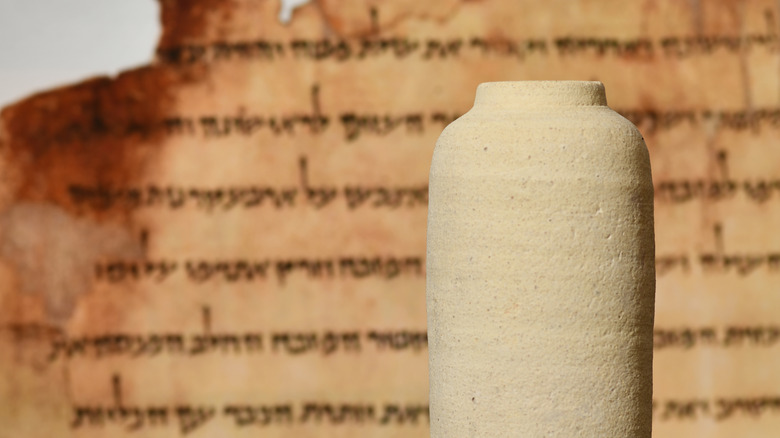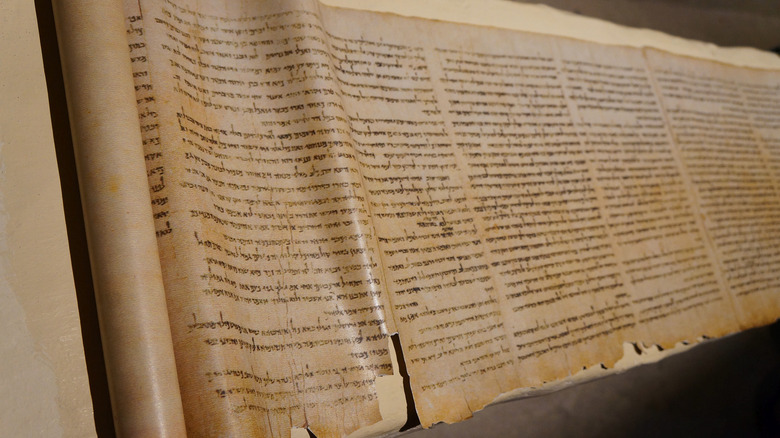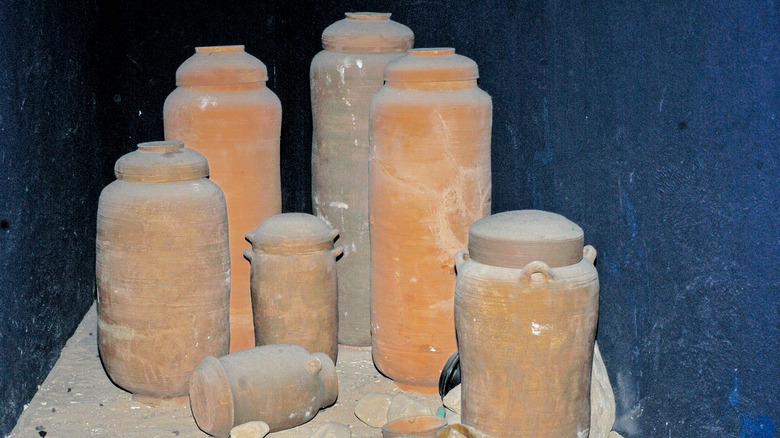What Is Actually Written In The Dead Sea Scrolls?
One of the most important archaeological discoveries of the past century, if not of all time, occurred in 1947, when a Middle Eastern shepherd happened upon some forgotten-about jars in a forgotten-about cave near the Dead Sea. As National Geographic reports, inside those jars were thousands of parchment scrolls, dating back 1,800 years. The significance of that find was initially lost on the people directly associated with it; as History explains, the scrolls were purchased by an antiquities dealer who later sold them. A cobbler with an interest in antiques bought a few and in turn sold them to a Syrian Orthodox archbishop for less than $100, and that archbishop ended up selling those four scrolls in the classified ads in 1954, when an Israeli archaeologist paid $250,000 for them.
The finding of the Dead Sea Scrolls marked a significant leap forward in the history of the Bible, according to World History Encyclopedia, at least in part by providing evidence and insights into the life of a Jewish community that lived around the time of Jesus. Further, the scrolls represented a literal treasure trove of examples of the state of Biblical scholarship at the time, as well as a look at the social and political issues of the day, even if scholars still aren't 100% sure who wrote and compiled the Dead Sea Scrolls (per History). Still, the way the scrolls were stored together in seven separate clay jars and discovered thousands of years later is reminiscent of an ancient time capsule.
They're mostly copies and translations of scripture
The Dead Sea Scrolls have been sorted by researchers into several categories, with sub-categories within them, according to the Leon Levy Dead Sea Scrolls Digital Library.
A good portion of the scrolls are given over to "biblical" scrolls. We use the word "biblical" here cautiously because the Bible, as a concept, didn't exist at the time, and the books were just an unofficial collection of documents that were important to the community. Nevertheless, copies of all of the books of the Old Testament, save for the Book of Esther, were found among the Dead Sea Scrolls — the oldest known copies still in existence, providing a treasure trove for historians and scripture scholars alike.
In addition to the biblical scrolls in their original languages are translations into languages the community would have spoken — Aramaic and Greek. Further still are scraps here and there containing singular passages, to be used as part of a ritual object. Outside of the biblical content, the scrolls contain such things as calendars, commentaries on the scriptures, copies of books not considered canonical, embellishment of biblical narratives, poetry, and various legal and historical documents related to the community. There were even 15 military letters among the scrolls. The scrolls probably belonged originally to a Jewish philosophical sect known as the Essenes, a group known for its commitment to sanctity.
And, according to History, the collection of scrolls also contains treasure maps, purportedly guiding the user to hidden caches of gold and silver. So far, none of those treasures have been found.
The Dead Sea Scrolls had different versions of some books in the Old Testament
In keeping with the idea of a time capsule, one thing of interest in the Dead Sea Scrolls was the realization that there were different versions of a few books of the Old Testament. According to Daniel Falk, Professor of Classics and Ancient Mediterranean Studies and Chaiken Family Chair in Jewish Studies at Penn State, the books of Exodus, Samuel, Jeremiah, Psalms and Daniel all had alternate versions, Falk wrote in The Conversation.
As Relevant Magazine reported, a big takeaway from the Dead Sea Scrolls was that the reason Old Testament scripture was varied was because it was manually copied and interpreted by different scribes, so "no two manuscripts are the same." Even though some view biblical text as hard and fast, through the Dead Sea Scrolls we can see the process by which the ancient stories were recorded and preserved.
The scrolls also included previously unknown Jewish religious writings, in which the Essenes shared their viewpoints and talked about their disagreements with other Jewish sects, but according to Falk, there is no mention of Jesus in the scrolls. Rather, it's an insight into the world in which Jesus was born into and lived, and most importantly, Falk wrote, it helped make clear why Jesus' teachings and message attracted disciples — people were expecting a messiah.
Falk wrote, "Both the Essenes and the early Christians believed they were living at the time foretold by prophets when God would establish a kingdom of peace and that their teacher revealed the true meaning of Scripture."


